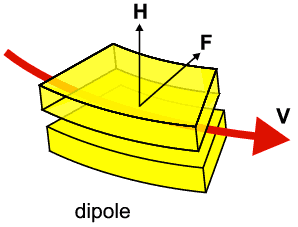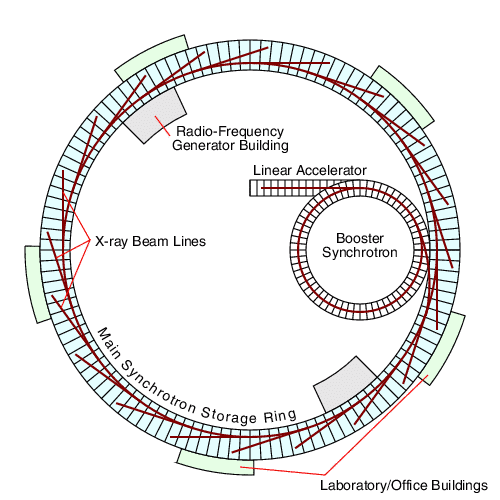 |
How do Synchrotrons Work? |
 Course Material Index
Course Material Index
 Section Index
Section Index
 Previous Page
Previous Page
 Next Page
Next Page
How do Synchrotrons Work?
It is a fundamental principle of physics, that when charged particles are
accelerated they give off electromagnetic radiation. An everyday example of
this effect is the radio-transmitter in which the particles being accelerated
are the electrons in the transmitter mast; here the accelerations are such that
the radiation produced is in the radio-frequency range. The most common
synchrotrons also use electrons though their speed and acceleration is such
that they produce electromagnetic radiation that is not only in the
radio-frequency range but also in the infra-red, visible, ultra-violet and
X-ray portion of the electromagnetic spectrum.
However we must first discuss the "building block" of synchrotrons, the
so-called dipole magnet which produces a vertical magnetic field, H, in
the gap between its poles (see below).
 The dipole magnet has two vital roles in the synchrotron. First, we recall
another basic principle of physics that if an electron, travelling in a
direction v (horizontal in above diagram), intersects a magnetic field
H in a direction perpendicular to v (H is vertical in
above diagram) then it will experience a force F (called the
Lorentz force) which is in a direction perpendicular to both v
and H ("inwards" as shown in the case above). Since the electron is
moving with velocity v, F produces a centripetal acceleration
causing the electron to move in a circular orbit. The second vital feature is
that because the electron is being accelerated within the dipole magnet it will
emit electromagnetic radiation; however we will return to this second essential
ingredient later. By ganging up a series of such dipole magnets around a circle
of the appropriate radius, it is obviously possible to make an electron move
around a closed loop (see below) consisting of curved (within the dipole
magnets) and straight (between the dipole magnets) sections.
The dipole magnet has two vital roles in the synchrotron. First, we recall
another basic principle of physics that if an electron, travelling in a
direction v (horizontal in above diagram), intersects a magnetic field
H in a direction perpendicular to v (H is vertical in
above diagram) then it will experience a force F (called the
Lorentz force) which is in a direction perpendicular to both v
and H ("inwards" as shown in the case above). Since the electron is
moving with velocity v, F produces a centripetal acceleration
causing the electron to move in a circular orbit. The second vital feature is
that because the electron is being accelerated within the dipole magnet it will
emit electromagnetic radiation; however we will return to this second essential
ingredient later. By ganging up a series of such dipole magnets around a circle
of the appropriate radius, it is obviously possible to make an electron move
around a closed loop (see below) consisting of curved (within the dipole
magnets) and straight (between the dipole magnets) sections.

This would comprise a simple synchrotron, often referred to more properly as a
ring or storage ring, though there are several other aspects and
components to consider. First we need a source of energetic electrons to feed
into the ring and this is done using a linear accelerator (linac) which
produces electrons at energies which can range from hundreds of MeV
(106 eV) to several GeV (109 eV). With some
synchrotrons (e.g. the SRS) a small "booster synchrotron", sited in
between the linac and the main synchrotron, is temporarily used during
"start-up" (referred to as injection) just to bridge some of the energy
gap between the output-MeV of the linac and the input-GeV required of the main
synchrotron ring. A key aspect of injection, however, is that the electrons are
injected in discrete pulses so that the electrons exist inside the
storage ring as bunches, typically one or two hundred bunches
distributed around the whole ring. This is essential for an effective action of
another synchrotron component, a radio-frequency generator/cavity, of
which there could be several around the ring. The purpose of this device is to
synchronously (hence the name synchrotron) feed energy to the electron
bunches circulating in the ring to compensate for their energy losses during
their emission of radiation. This current of electron bunches slowly decays
with time due to collisions between the electrons and any molecules contained
within the ring; even with ultra-high vacuum conditions (typically
10-10 mbar) in the storage ring, the storage beam typically needs to
be regenerated about every 24 hours. A very basic plan for a synchrotron might
be:
 The brown lines denote the paths of the synchrotron radiation
emitted as the bunches of electrons pass
through the dipole magnets; this produces a "Catherine
wheel" effect. The properties of synchrotron radiation are considered in the
next part.
The brown lines denote the paths of the synchrotron radiation
emitted as the bunches of electrons pass
through the dipole magnets; this produces a "Catherine
wheel" effect. The properties of synchrotron radiation are considered in the
next part.
 Course Material Index
Course Material Index
 Section Index
Section Index
 Previous Page
Previous Page
 Next Page
Next Page




